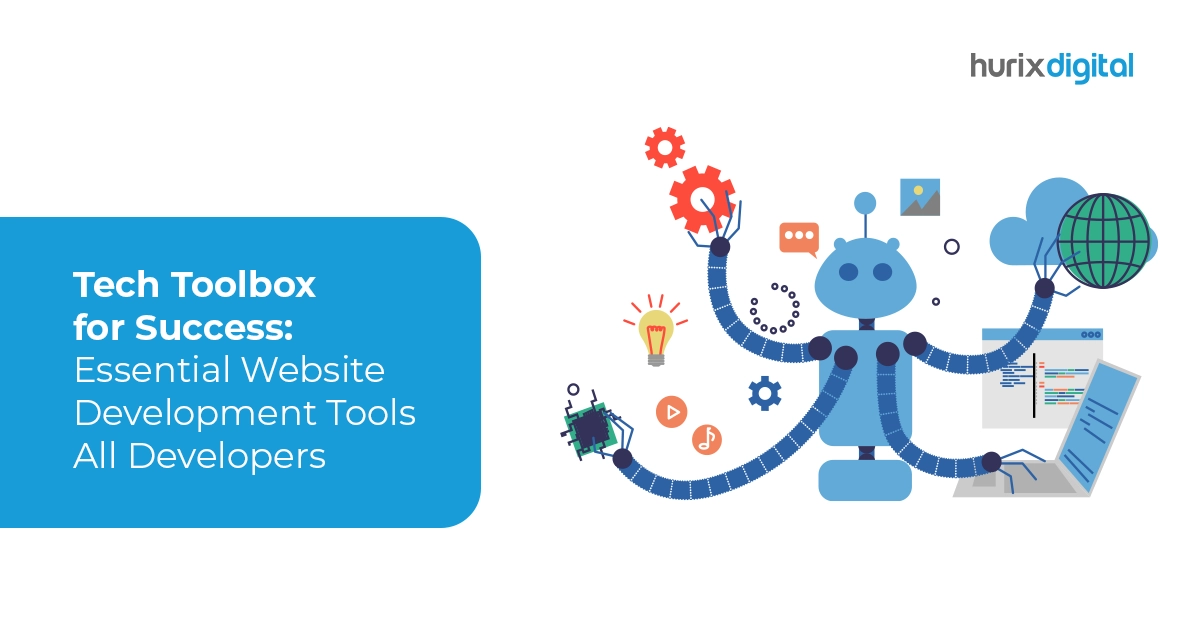
Tech Toolbox for Success: Essential Website Development Tools All Developers
In the ever-evolving landscape of web application development, having the right set of website development tools is crucial for success. These tools not only streamline the development process but also enhance efficiency, improve collaboration, and ensure high-quality results.
Table of Contents
- Code Editors and IDEs
- Version Control Systems
- Design and Prototyping Tools
- Testing and Debugging Tools
- Website Automation Tools
2. Additional Categories for Web Development
- Preprocessors and CSS Frameworks
- Performance Optimization Tools
- Accessibility Testing Tools
- Project Management and Communication Tools
- Learning and Community Resources
3. Conclusion
Whether you’re a seasoned developer or just starting out, choosing the right website development software can significantly impact your workflow and project outcomes. This blog delves into a carefully selected list of essential tools that cater to various aspects of web development, empowering you to make informed choices and build exceptional websites.
Website Development Tools
1. Code Editors and IDEs:
The foundation of any development project lies in writing clean and efficient code. Code editors and Integrated Development Environments (IDEs) provide developers with a platform to write, edit, and debug code effectively. Some popular options include:
-
-
-
- Visual Studio Code: A versatile and customizable code editor with extensive functionality, supporting various programming languages and frameworks.
- Sublime Text: Known for its speed and flexibility, offering powerful features for code editing and manipulation.
- WebStorm: A dedicated IDE specifically designed for web development, providing intelligent code completion, debugging tools, and built-in support for popular web technologies.
-
-
2. Version Control Systems:
Effectively managing code changes and collaborating with team members is essential for any development project. Version control systems (VCS) like Git allow developers to track changes, revert to previous versions, and collaborate seamlessly on codebases.
-
-
-
- Git: The industry-standard VCS, offering robust features for version control, branching, and merging, facilitating efficient collaboration among developers.
-
-
3. Design and Prototyping Tools:
Bridging the gap between design and development, web design platforms and prototyping tools enable developers to visualize website layouts, user flows, and interactions before coding begins. This streamlines the development process and ensures the final product aligns with design expectations.
-
-
-
- Figma: A popular web-based design tool offering collaborative features, allowing designers and developers to work on the same project simultaneously.
- Adobe XD: A comprehensive design and prototyping tool from Adobe, enabling the creation of interactive prototypes and user flows for websites and mobile applications.
-
-
4. Testing and Debugging Tools:
Ensuring a website functions flawlessly across different browsers and devices is crucial. Website development tools like browser developer consoles and testing frameworks help identify and fix bugs, optimize performance, and guarantee a seamless user experience.
-
-
-
- Browser Developer Tools: Built-in developer tools offered by popular browsers like Chrome and Firefox provide functionalities for debugging code, inspecting elements, and monitoring website performance.
- Selenium: An open-source framework for automated web browser testing, enabling developers to write test scripts and simulate user interactions to identify potential issues.
-
-
5. Website Automation Tools:
Repetitive tasks can hinder development speed and efficiency. Website automation tools help automate various aspects of the development process, such as testing, deployment, and build processes, freeing up developer time for more strategic tasks.
-
-
-
- Gulp: A popular task runner for automating repetitive tasks in web development workflows, streamlining processes and improving efficiency.
- Grunt: Another task runner option, offering similar functionalities to Gulp for automating various development tasks.
-
-
Also read, The Impact of Artificial Intelligence on Website Development
Additional Categories for Web Development
Beyond the core tools mentioned above, a vast array of valuable resources exists to further enhance your development proficiency.
1. Preprocessors and CSS Frameworks:
-
-
-
- Preprocessors: These tools like Sass and LESS extend the capabilities of CSS, allowing for variables, mixins, and functions, promoting cleaner and more maintainable code.
- CSS Frameworks: Frameworks like Bootstrap and Tailwind CSS provide pre-built styles and components, accelerating development by offering ready-made solutions for common UI elements.
-
-
2. Performance Optimization Tools:
-
-
-
- Google PageSpeed Insights: This free tool from Google analyzes your website’s performance and offers actionable recommendations for improvement, helping you optimize loading times and user experience.
- GTmetrix: Another popular performance analysis tool, providing detailed insights into website speed, including recommendations for image optimization, caching strategies, and code minification.
-
-
3. Accessibility Testing Tools:
-
-
-
- WAVE Web Accessibility Evaluation Tool: This online tool from WebAIM helps identify potential accessibility issues on your website, ensuring your website is usable by everyone, regardless of abilities.
- aXe (Accessibility Engine): Another accessibility testing tool, offering more comprehensive evaluations and integration with various development workflows.
-
-
4. Project Management and Communication Tools:
-
-
-
- Trello: A popular project management tool facilitating task organization, collaboration, and communication within development teams.
- Slack: A widely used communication platform enabling real-time communication and information sharing among team members, streamlining collaboration efforts.
-
-
5. Learning and Community Resources:
-
-
-
- Online Courses and Tutorials: Numerous online platforms offer comprehensive courses, tutorials, and documentation on various web development topics, catering to all skill levels.
- Developer Communities and Forums: Engaging with online communities and forums allows you to connect with other developers, share knowledge, troubleshoot challenges, and stay updated on the latest trends and technologies.
-
-
Read more: Website Development Trends to Watch in 2024
Investing in Continuous Learning:
The world of web development is constantly evolving, with new tools, frameworks, and best practices emerging regularly. To stay ahead of the curve and maintain your competitive edge, continuous learning is essential. Dedicate time to exploring new technologies, experimenting with different tools, and staying updated on industry trends.
Read more: Streamline Your Website Development Process in 4 Simple Stages!
Conclusion:
Equipping yourself with the right website development tools and continuously expanding your knowledge base are essential for success in this dynamic field. By carefully selecting tools that align with your project needs, embracing a growth mindset, and fostering collaboration, you can navigate the ever-changing landscape of web development and build exceptional websites that not only function flawlessly but also captivate your audience and achieve your business objectives.
Partner with Hurix Digital for Comprehensive Development Solutions:
At Hurix Digital, we are committed to empowering businesses and developers with the resources and expertise needed to thrive in the digital age. Our team of experienced professionals possesses a deep understanding of the latest website development tools and technologies. We offer a comprehensive range of services, including web development services, website design and development services, and SEO services, to help you build, optimize, and maintain high-performing websites that deliver exceptional user experiences and drive business growth.
Contact us today for a free consultation and discover how we can partner with you to achieve your online goals.

Currently serving as the Vice President of Technology Delivery Operations at HurixDigital, a prominent global provider of digital content and technology solutions for publishers, corporations, and educational institutions. With over 16 years of experience spanning EdTech and various domains, I hold certification as a SCRUM Product Owner (CSPO). My expertise includes operations, finance, and adept people management skills.






